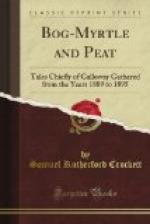For the most part the walkers were young men with companions of their own sex and age, who were anxious to be considered broad in their views. Times have changed now, for we hear that quite respectable folk, even town-councillors, take their walks openly on Sabbath afternoons. It was otherwise in those days.
But none of their own kind did the Drumquhat folk meet or overtake, till at the bottom rise of the mile-long Whinnyliggate Wood the red cart came up with the three brave little old maids who, leaving a Free kirk at their very door, and an Established over the hill, made their way seven long miles to the true kirk of the persecutions.
It had always been a grief to them that there was no Clavers to make them testify up to the chin in Solway tide, or with a great fiery match between their fingers to burn them to the bone. But what they could they did. They trudged fourteen miles every Sabbath day, with their dresses “fait and snod” and their linen like the very snow, to listen to the gospel preached according to their conscience. They were all the smallest of women, but their hearts were great, and those who knew them hold them far more worthy of honour than the three lairds of the parish.
Of them all only one remains. (Alas, no more!) But their name and honour shall not be forgotten on Deeside while fire burns and water runs, if this biographer can help it. The M’Haffies were all distinguished by their sturdy independence, but Jen M’Haffie was ever the cleverest with her head. The parish minister had once mistaken Jen for a person of limited intelligence; but he altered his opinion after Jen had taken him through-hands upon the Settlement of “Aughty-nine” (1689), when the Cameronians refused to enter into the Church of Scotland as reconstructed by the Revolution Settlement.
The three sisters had a little shop which the two less active tended; while Mary, the business woman of the family, resorted to Cairn Edward every Monday and Thursday with and for a miscellaneous cargo. As she plodded the weary way, she divided herself between conning the sermons of the previous Sabbath, arranging her packages, and anathematising the cuddy. “Ye person—ye awfu’ person!” was her severest denunciation.
Billy was a donkey of parts. He knew what houses to call at. It is said that he always brayed when he had to pass the Established kirk manse, in order to express his feelings. But in spite of this Billy was not a true Cameronian. It was always suspected that he could not be much more than Cameronian by marriage—a “tacked-on one,” in short. His walk and conversation were by no means so straightforward, as those of one sound in the faith ought to have been. It was easy to tell when Billy and his cart had passed along the road, for his tracks did not go forward, like all other wheel-marks, but meandered hither and thither across the road, as though he had been weaving some intricate web of his own devising. He was called the Whinnyliggate Express, and his record was a mile and a quarter an hour, good going.




